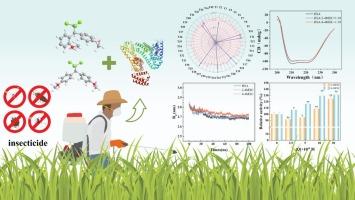Spectroscopic and in silico insight into the influence of substituent position on the molecular interaction mechanism between methoxychlor and human serum albumin
IF 4.6
2区 化学
Q1 SPECTROSCOPY
Spectrochimica Acta Part A: Molecular and Biomolecular Spectroscopy
Pub Date : 2025-09-12
DOI:10.1016/j.saa.2025.126938
引用次数: 0
Abstract
P,p’-Methoxychlor (4-4MXC), an insecticide banned under the Stockholm Convention, exhibits significant environmental persistence and poses health risks. However, the interaction mechanisms of 4-4MXC and its isomer (2-4MXC) with transport proteins remain poorly understood. This study investigated the influence of structural differences on their functionality by evaluating the toxicity variations between 2-4MXC and 4-4MXC and their interactions with HSA. ProTox 3.0 analysis revealed similar toxicity properties for both isomers. They spontaneously bound to HSA at site I via hydrophobic interactions mediated by Arg218 and Trp214. In fluorescence experiments, the binding constants of 4-4MXC were consistently higher than those of 2-4MXC at three temperatures (298 K, 303 K, and 310 K). This can be attributed to its larger negative surface area, which facilitates stronger binding to HSA. 4-4MXC induced a greater reduction in α-helix content (5.0% compared to 3.5% for 2-4MXC) and an increased radius of gyration, indicating more pronounced structural relaxation. Functional assays demonstrated isomer-specific effects: 4-4MXC significantly activates the activity, while 2-4MXC shows slight inhibition at concentrations below 10 × 10−6 M−1, transitioning to activation at higher concentrations. These differences stemmed from distinct effects on the accessible surface areas of catalytic residues (Lys199/Lys195). These findings highlight the structure-dependent binding of isomers to HSA, leading to variations in their functional properties.

取代基位置对甲氧基氯与人血清白蛋白分子相互作用机制影响的光谱和计算机分析。
P, P '-甲氧基氯(4-4MXC)是一种被《斯德哥尔摩公约》禁止的杀虫剂,具有显著的环境持久性,并构成健康风险。然而,4-4MXC及其异构体(2-4MXC)与转运蛋白的相互作用机制仍然知之甚少。本研究通过评价2-4MXC和4-4MXC的毒性差异及其与HSA的相互作用,探讨了结构差异对其功能的影响。ProTox 3.0分析显示两种异构体的毒性相似。它们通过Arg218和Trp214介导的疏水相互作用在I位点自发地与HSA结合。在荧光实验中,4-4MXC在298 K、303 K和310 K三种温度下的结合常数均高于2-4MXC。这可以归因于其更大的负表面积,这有利于更强的结合HSA。4-4MXC诱导α-螺旋含量降低(5.0%,而2-4MXC为3.5%),旋转半径增加,表明结构松弛更为明显。功能分析显示了同分异构体特异性效应:4-4MXC显著激活活性,而2-4MXC在浓度低于10 × 10-6 M-1时表现出轻微的抑制作用,在浓度较高时转为激活。这些差异源于对催化残基(Lys199/Lys195)可达表面积的不同影响。这些发现强调了异构体与HSA的结构依赖性结合,导致其功能特性的变化。
本文章由计算机程序翻译,如有差异,请以英文原文为准。
求助全文
约1分钟内获得全文
求助全文
来源期刊
CiteScore
8.40
自引率
11.40%
发文量
1364
审稿时长
40 days
期刊介绍:
Spectrochimica Acta, Part A: Molecular and Biomolecular Spectroscopy (SAA) is an interdisciplinary journal which spans from basic to applied aspects of optical spectroscopy in chemistry, medicine, biology, and materials science.
The journal publishes original scientific papers that feature high-quality spectroscopic data and analysis. From the broad range of optical spectroscopies, the emphasis is on electronic, vibrational or rotational spectra of molecules, rather than on spectroscopy based on magnetic moments.
Criteria for publication in SAA are novelty, uniqueness, and outstanding quality. Routine applications of spectroscopic techniques and computational methods are not appropriate.
Topics of particular interest of Spectrochimica Acta Part A include, but are not limited to:
Spectroscopy and dynamics of bioanalytical, biomedical, environmental, and atmospheric sciences,
Novel experimental techniques or instrumentation for molecular spectroscopy,
Novel theoretical and computational methods,
Novel applications in photochemistry and photobiology,
Novel interpretational approaches as well as advances in data analysis based on electronic or vibrational spectroscopy.

 求助内容:
求助内容: 应助结果提醒方式:
应助结果提醒方式:


